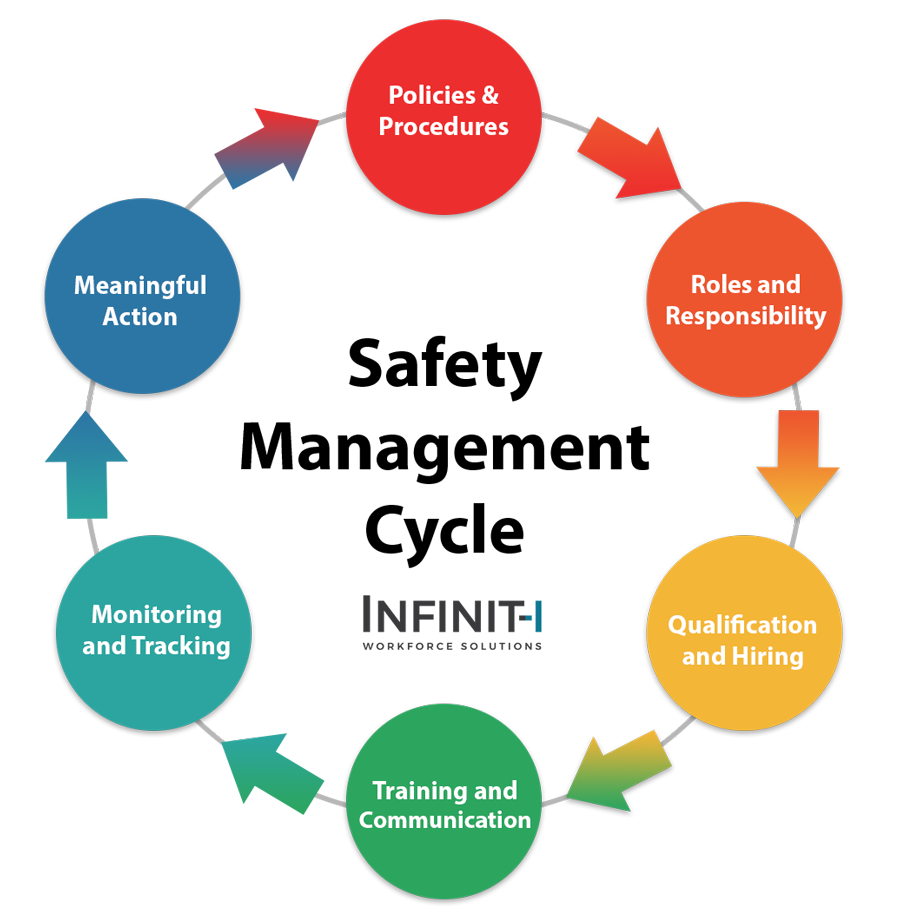6 Biggest Benefits of an LMS for Transportation Companies
- Increased driver comprehension of training material
- Decreased frequency and severity of accidents and incidents
- Improved CSA scores
- Digital, automatic record-keeping provides indisputable proof of training in legal matters and DOT audits
- Streamlined communication and shortened driver orientation
- Improved ability to provide corrective action training
Seeing is Believing
How can Infinit-I Workforce Solutions help?
Training specific to each BASIC should be provided
Infinit-I Workforce Solutions has a successful training program for each of the seven CSA BASIC’s. Training customized with your company’s policies and standards can be added to your classroom to ensure full understanding of company expectations.
Training should focus on the potential violations in each BASIC
Infinit-I Workforce Solutions’ training provides drivers with increased exposure and awareness of the consequences of violating any of the seven BASIC’s.
Training should be more or less continuous
Infinit-I Workforce Solutions offers web-based training that is accessible 24/7.
Training should be short, concise and focused on one topic at a time
Infinit-I Workforce Solutions provides courses that are roughly 5-7 minutes in duration maximizing the attention of the individual.
All training should be tested and test scores communicated to management
Infinit-I Workforce Solutions offers testing following each training course allowing you to measure the learning effectiveness of each driver. Testing is tracked and reported to management.
Minimum acceptable test scores should be required
Infinit-I Workforce Solutions offers multiple options for determining minimum acceptable test scores.
Regular monitoring of safety training completed for each BASIC is a must
Infinit-I Workforce Solutions keeps track of all completed training courses and provides third-party reporting that verifies the specific date and time of each completed course.
Management review of safety training reports
Infinit-I Workforce Solutions will email reports to our customers documenting all training completed for the respective week; at no additional charge!
Immediate remediation required if violation occurs
Infinit-I Workforce Solutions can offer targeted training courses for violations and track the progress of the driver. The LMS will notify you if a driver does not complete required training.

FMSCA Safety Management Cycle
The Safety Management Cycle (SMC) tool is designed to help motor carriers establish and improve appropriate safety management controls, thereby reducing or eliminating violations.
A motor carrier can use the SMC at any time; however, it can be particularly helpful to a motor carrier after it has reviewed its violations and crash history on the Safety Measurement System (SMS).
Applying the SMC is a step-by-step process that looks at “why” the safety and compliance issues are occurring rather than just identifying the violation (the “what”). The tool provides a framework for brainstorming remedies, choosing solutions, and designing and implementing plans to improve the motor carriers’ safety operations. The SMC consists of six Safety Management Processes (SMPs) that reflect the six areas of a motor carrier’s operations.
- Policies and Procedures defines the “what” and “how” of a motor carrier’s operations. Policies establish the guidelines for how motor carriers and their employees behave in a given situation. Procedures explain how to accomplish policies. The other five SMPs focus on how to implement the policies and procedures.
- Roles and Responsibilities clearly defines what each employee should do to successfully implement the policies and procedures.
- Qualification and Hiring discusses recruiting and screening applicants to fulfill the roles and responsibilities for positions.
- Training and Communication outlines a motor carrier’s communication of its policies, procedures, roles, and responsibilities so that everyone understands the expectations and has the adequate skills and knowledge to perform their assigned function.
- Monitoring and Tracking concentrates on the need to have a system in place to monitor and track employee performance that enables companies to be aware of their employees’ safety performance and compliance with its policies and procedures and how they execute their roles and responsibilities. Monitoring represents the motor carrier looking at the performance of the operation, and Tracking is assessing the data collected leading to Meaningful Action.
- Meaningful Action gives motor carriers the tools to correct or improve employee behavior, including, for example, refresher training and positive reinforcement such as rewards or bonuses, in order to improve the motor carrier’s overall safety performance.
The SMC is used by the FMCSA during investigations. The SMC is also useful in helping motor carriers identify and take actions to improve their safety compliance. Below are the general steps a motor carrier should follow in applying the SMC to its operation.
- Review the company’s violations and crash history on the SMS for trends.
- Assess each of the SMPs, starting with the Policies and Procedures, to determine which contains process breakdowns that contribute to crashes and/or violations. Each SMP highlights the kinds of safety management controls that are needed to ensure strong safety performance and where they may be breaking down. A company uses the SMC to identify which processes are not working well and are contributing to the motor carrier’s violation(s) of the FMCSRs and/or crashes.
- Assess why the breakdowns are occurring in that process and identify Safety Improvement Practices (SIPs) to address these problems. SIPs are identified within each SMP and motor carriers can implement them to begin improving their safety performance.
- Select and prioritize SIPs to address improving safety compliance, create an implementation plan appropriate for company size and available resources, implement the plan, and monitor and track progress and the effect on the company’s BASIC percentile ranks over time.


